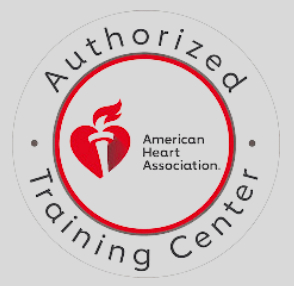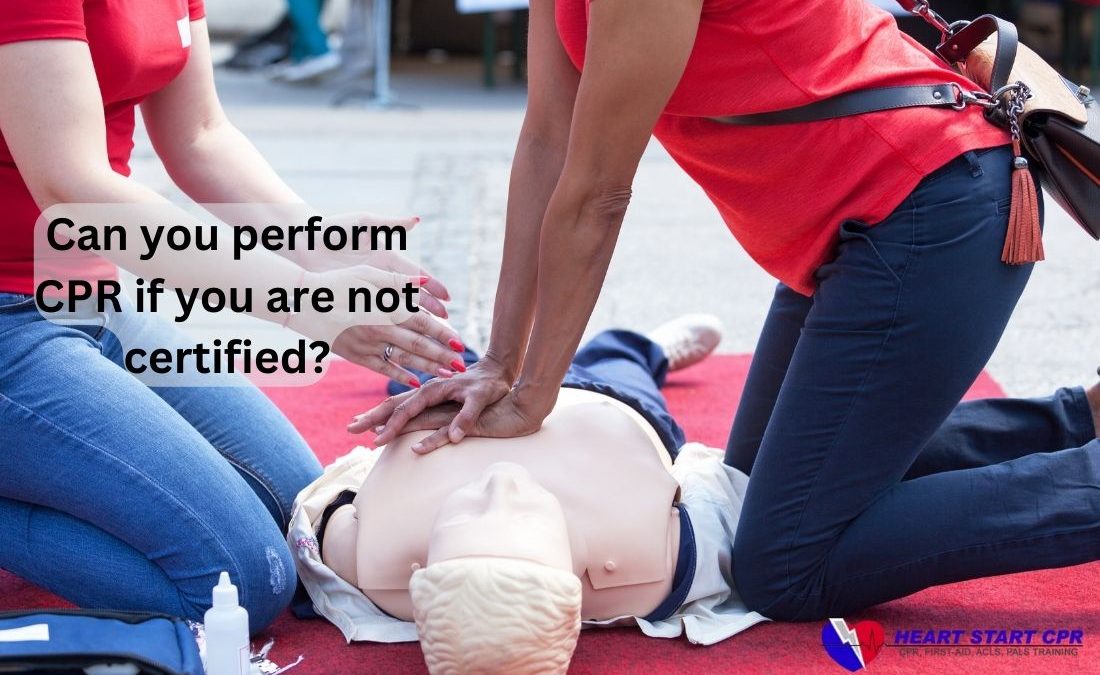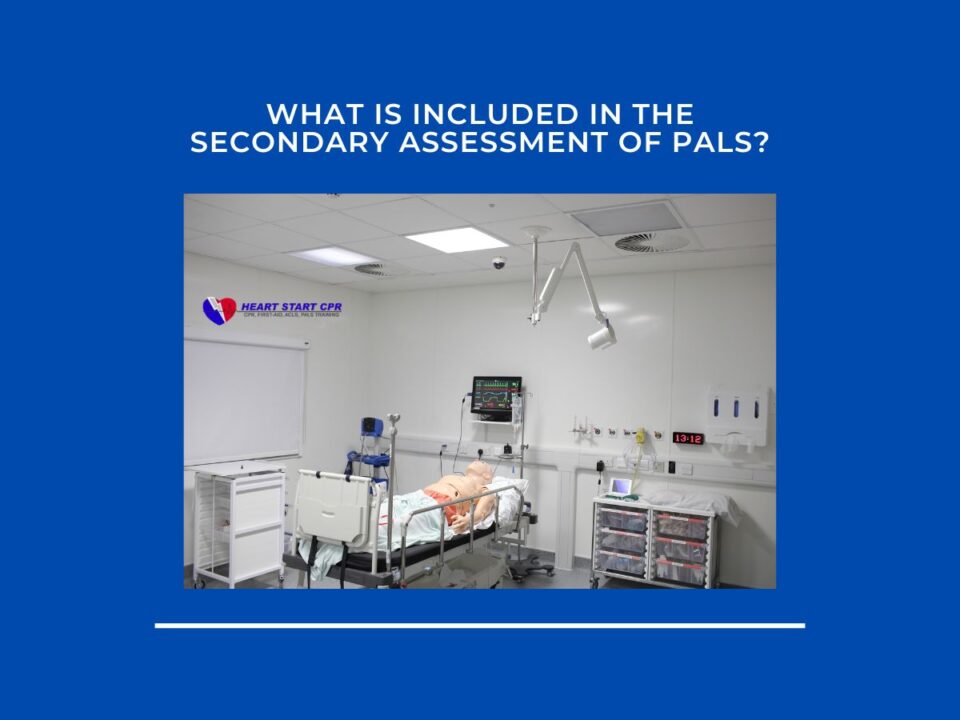
Empowering Youth: Benefits of CPR Education in High Schools
January 20, 2023
PALS: Understanding the Basic & Everything You Need To Know
January 24, 2023Table of contents
- The importance of proper training in performing CPR
- CPR certified meaning and benefits of being CPR Certified
- Difference between certified and non-certified CPR
- Potential risks and liabilities of performing CPR without certification
- Importance of following local laws and regulations regarding CPR certification
- Can you get sued for giving cpr?
- Get CPR Certified From Heart Start CPR
Sudden Cardiac Arrest is one of the leading causes of death in the United States. If the Person receives CPR in time, the chance of survival increases. But Can You Perform CPR If You Are Not Certified?
While it is possible to perform CPR without certification, it is recommended that individuals receive proper training and certification before attempting to perform CPR. Proper training and certification provide individuals with the necessary skills and knowledge to respond to an emergency effectively. However, in an emergency where no certified individual is available, attempting CPR is better than doing nothing.
The importance of proper training in performing CPR
Proper training in performing CPR is essential for ensuring the safety and well-being of the person receiving CPR and the person administering it. CPR, or cardiopulmonary resuscitation, is a life-saving technique to restart a person's heart and breathing during cardiac arrest.
However, CPR can cause harm or even death if performed incorrectly or without proper training.
When a person is trained in CPR, they learn how to perform chest compressions and rescue breathing properly and how to use an automated external defibrillator (AED) if one is available. They also learn how to recognize the signs of cardiac arrest and properly respond in an emergency.
Proper training also includes learning about the latest guidelines and protocols for CPR, which change over time as new research and data become available. This ensures that the person performing CPR uses the most up-to-date and effective techniques. In addition, proper training teaches the importance of good hygiene to avoid cross-contamination and infection to both the rescuer and the person needing CPR.
CPR certified meaning and benefits of being CPR Certified
CPR certified" means that an individual has completed a course in cardiopulmonary resuscitation (CPR) and has been evaluated by a certified instructor to demonstrate the knowledge and skills necessary to perform CPR correctly. CPR is a lifesaving technique used in emergencies to help restore breathing and circulation in a person who has suffered cardiac arrest or other medical emergencies. Being CPR certified means that the individual has been trained to perform CPR effectively and safely and is qualified to respond to emergencies where CPR may be necessary. Becoming certified in CPR can offer several benefits for both the person performing CPR and the person receiving it.
- One of the main benefits of becoming certified in CPR is that the person will be able to perform the technique correctly and safely. This means that they have a better understanding of performing chest compressions, rescue breathing, and using an automated external defibrillator (AED). They also learn how to recognize the signs of cardiac arrest and respond to an emergency properly.
- Certification in CPR ensures that the person is aware of the latest guidelines and protocols for the technique, which can change over time as new research and data become available. This means that the person is using the most up-to-date and effective technique.
- Becoming certified in CPR also benefits the person's career. Many employers and organizations require CPR certification for certain positions, especially those in healthcare, emergency services, and other fields where CPR may be needed.
- CPR Training also increases the person's confidence and readiness to respond to emergencies.
Difference between certified and non-certified CPR
The difference between certified and non-certified CPR refers to whether or not a person has completed a formal CPR training program and has been certified by a recognized organization.
Certified CPR refers to training programs taught by certified instructors, including classroom instruction and hands-on practice. These programs usually follow the guidelines set by organizations such as the American Heart Association (AHA) or the American Red Cross (ARC) and involve a written test and a skills assessment. Upon completion, the person receives a certification card valid for a certain period, usually two years.
Non-certified CPR, on the other hand, refers to CPR performed by a person who has yet to complete a formal training program and does not have a valid certification. This could include someone who has learned CPR through a brief demonstration or online course or who has known the technique through personal experience.
It is important to note that non-certified CPR may not be as effective as certified CPR, as the person performing it may not have the same level of knowledge or skill. Additionally, non-certified CPR may need to comply with the latest guidelines and protocols, which can change over time.
While the law may vary depending on the jurisdiction, non-certified CPR is generally legal and can be performed by any individual in an emergency. However, certification is highly recommended, as it improves the chances of a successful outcome. Some employers or organizations may also require it.
Potential risks and liabilities of performing CPR without certification
Performing CPR without certification can pose potential risks and liabilities for the person administering CPR and receiving it. Following are some of the
- One of the main risks of CPR without a certificate is the possibility of causing harm or injury to the person receiving CPR. If the technique is performed incorrectly, it can lead to broken ribs, punctured lungs, or other damages.
- Suppose the person administering CPR is not trained to recognize the signs of cardiac arrest. In that case, they may perform CPR on someone who does not need it, which can cause unnecessary harm.
- Another risk is that the person performing CPR without certification is not aware of the latest guidelines and protocols for CPR, which change over time. This means that they may not be using the most up-to-date and effective techniques, which can reduce the chances of a successful outcome.
- Regarding liabilities, a person who performs CPR without certification may be liable for any harm or injury caused to the person receiving CPR. This can include legal action taken by the person or their family and potential disciplinary action taken by employers or organizations.
- Additionally, suppose the person performing CPR without certification fails to follow the laws and regulations regarding CPR certification. In that case, they may face penalties or fines.
Performing CPR without certification can pose potential risks and liabilities for both the person administering CPR and the person receiving it, as it can lead to harm or injury, reduce the chances of a successful outcome, and expose the person performing CPR to legal or administrative action.
Importance of following local laws and regulations regarding CPR certification
Local laws and regulations regarding CPR certification are important for ensuring the person performing CPR is qualified and trained. The technique must comply with the latest guidelines and protocols.
Laws and regulations regarding CPR certification vary depending on the jurisdiction. They may be established at the federal, state, or local level. These laws and regulations can include requirements for training and certification, as well as guidelines for when and how CPR can be performed.
By following these laws and regulations, the person performing CPR can ensure they are qualified and use the most up-to-date and effective techniques. Additionally, if a person is performing CPR within the scope of their job, following the laws and regulations can help to protect their employer from any potential legal liabilities.
Additionally, it is important to note that some states or organizations may have “Good Samaritan” laws or policies that may protect the person performing CPR from being held liable if they acted in good faith and did not act recklessly.
Can you get sued for giving cpr?
Are you aware of the lifesaving procedure called Cardiopulmonary resuscitation (CPR)? It can be the difference between life and death for someone experiencing cardiac arrest. However, many people hesitate to perform CPR because of fear of causing harm or legal repercussions. Can I get sued for performing CPR? Fortunately, there are laws in place to protect individuals who perform CPR in good faith. These laws are called Good Samaritan laws.
CPR is considered a medical procedure and can be dangerous if performed incorrectly. However, Good Samaritan laws protect individuals who attempt CPR in good faith. That means you can take action without fear of legal consequences. It's important to note that in most states, Good Samaritan laws require individuals to obtain consent from the person needing assistance before performing CPR. If the person is unconscious or otherwise unable to consent, individuals may assume they would consent to lifesaving measures. With good Samaritan laws in place, you can feel confident in taking action to perform CPR in an emergency. Knowing your legal rights can make a significant difference in saving someone's life.
Get CPR Certified From Heart Start CPR

Every one needs to learn basic life support skills, as it's one of the most have skill even for general people. Are you ready to be the one who can save a life in an emergency? Get certified in CPR with Heart Start CPR's comprehensive training program. Our expert instructors provide hands-on training, the latest guidelines, and a certification card valid for two years. Don't wait any longer; enroll now in our online BLS certification course and be a difference in someone's life!






